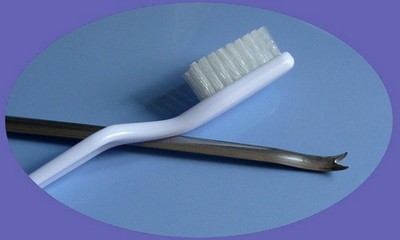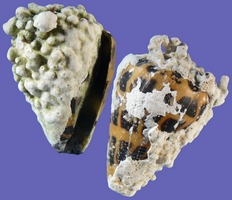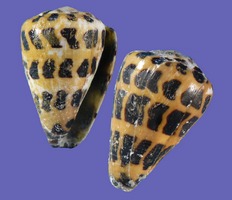
Here come the unpleasant part (well, at least from my point of view). But you must not get discouraged, performing this step is the only way to have a nice looking collection. And more important, it is sometime necessary for the identification phase.
You know that mollusks are animal. When seashells are collected alive, the animal is still inside its shell. Even collected beached,
some shells can still have the body or part of it inside.
So, the first thing to do is to remove the body from its shell, and there are quite a few ways to do it:
- Leaving the body to rot: if you can leave the shell in a temperate and wet place, the body will start to rot and to self-digest.
After a few days it will become really stinky but rinsing it under a strong water current (a gardening hose will do perfectly) aimed at the shell aperture
or valves, it will flush the decaying flesh out of the shell.
- Boiling the shells: Just like if you wanted to cook the shells, put them in boiling water and after a certain duration
(according to the animal size) you will be able to remove the body. It work especially well with bivalves. For gastropods, use a hooked device
to extract the animal. Sometime parts of the body stay inside the shell after extraction, in these case, use an other way to finish clear
the shell.
- Freezing the shells: I have heard of this technique but I have never been successful in performing it. It is said that after
a few sequences of freezing - unfreezing, the body can be easily extracted just like after boiling.
- Use of chemicals: Alcohol and formol can be used, it is better with small shells. After 5-6 days of drowning (it is faster with formol),
remove the shell from the solution and leave it outside in an open place. The body will dry inside the shell without leaving any discomfortable odour.
- Bleaching: Bleach can also be used to remove parts of body locked inside a gastropod spire. Pour bleach in the shell in a way that
enable the liquid to reach the bottom of the spire. Leave it for a few hours, during that time the bleach dissolves flesh remains. Then rinse the shell.
Warning, do not do that with glossy shells as bleach may stain them (cowries, olives, etc.).

This can be done quite easily.
First remove algae as much as you can with a sponge or any rubbing device that would not scratch the shell.
When you have removed most of it, finish cleaning by sinking the shell in concentrated bleach for 1 or 2 hours,
stir occasionnely to help the chemical process. In the meantime it will dissolve parts of flesh that may remain inside.
Same warning as previously, do not do that with glossy shells as bleach will stain them.
You should end up with a clean shell, and the only thing that might be left to do is to clean the calcareous deposits.
The first thing to do is trying to remove manually the calcareous parts, using a hooked and sharp piece of metal will often be enough to
unstick the deposits, wearing protection glasses while doing it is highly recommended. Also, be careful not to scratch the shell with
the tool.
If the deposits are too strong, it is possible to soften them using acids or white vinegar. Be careful with acid, it is very corrosive. The shell can also
suffer damages from this treatment, try to apply locally these chemicals or limit bathes to the shortest duration possible.
Finish the treatment by soaping and rinsing the shell. Leave it to dry in a place without sunlight.
 |
 |
 |
| beached Conus ebraeus shells just after pick-up |
After the removal of calcareus deposit with a piece of metal |
And the same shells after the bleach bath that removed periostracum and algae deposits |